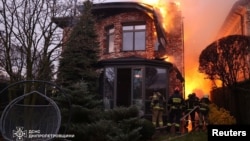Tensions heightened over Moscow’s war on Ukraine Thursday, with Russian President Vladimir Putin saying it had targeted the Ukrainian city of Dnipro with a new intermediate-range missile in response to the United States and Britain sending Kyiv its longer-range missiles for use against Russia.
Ukraine claimed Russian forces targeted it with an intercontinental ballistic missile, but U.S. officials said their assessment was that it was an intermediate-range missile, which, hours later, Putin acknowledged.
Putin warned during a nationwide address that Russia could use the weapon, which has a range of 800 kilometers, against countries that have allowed Kyiv to use their missiles to strike Russia.
"A regional conflict in Ukraine previously provoked by the West has acquired elements of a global character," Putin said in the televised address.
He said Russia would issue advance warnings if it launched more strikes with the intermediate-range missiles to allow civilians time to evacuate safely. He claimed that U.S. air defense systems would not be capable of intercepting the new missiles.
Ukrainian President Volodymyr Zelenskyy said in a posting on X, following Putin’s address that Thursday’s attack was "yet more proof that Russia has no interest in peace. ... The world must respond. ... A lack of tough reactions to Russia’s actions sends a message that such behavior is acceptable," he wrote.
The most significant feature of the missile that Russia launched into Ukraine was its payload, Fabian Hoffmann, a doctoral research fellow at Oslo University told Reuters. The payload, a multiple independently targetable reentry vehicle, "is exclusively associated with nuclear-capable missiles," he said.
He said Russia used the weapon for "signaling purposes."
The Ukrainian air force said the missile was launched from Russia’s Astrakhan region and was part of a wider set of attacks that included a hypersonic missile and seven cruise missiles.
Ukrainian officials reported that the missile attacks wounded two people and damaged an industrial site in the Dnipropetrovsk region. Regional Governor Serhiy Lysak said the attacks hit the city of Dnipro and caused several fires.
A U.S. official said the United States briefed Ukraine and close allies in recent days to help them prepare for the possible use of an experimental intermediate-range ballistic missile, as was used in Thursday’s attack.
At the Pentagon, deputy press secretary Sabrina Singh confirmed Russia’s launch of an experimental intermediate range ballistic missile.
"The United States was pre-notified briefly before the launch through nuclear risk reduction channels," she told reporters Thursday.
Russia likely possesses only a handful of the experimental intermediate-range ballistic missiles, the official said.
When asked by reporters Thursday about a potential escalation in the conflict, White House press secretary Karine Jean-Pierre pointed to North Korean troops fighting for Russia against Ukraine.
"When you are thinking about bringing in thousands of troops to the front lines to add to the war, right — these are North Korean troops, as you know — that is the aggression from Russia’s part. That’s their aggression," Jean-Pierre said. "We are going to continue to be there for Ukraine."
Elsewhere, Volodymyr Artiukh, governor of Ukraine’s Sumy region, said on Telegram that Russian forces shelled areas along the border between the two countries and attacked with an aerial drone.
Russia’s Defense Ministry said its air defenses destroyed two Ukrainian drones over the Rostov region and two drones over Volgograd. It also said it shot down two British-made Storm Shadow cruise missiles.
Yuri Slyusar, the acting governor of Rostov, said on Telegram that the Ukrainian attack caused no damage or casualties.
VOA Pentagon correspondent Carla Babb contributed to this report. Some information was provided by Reuters and The Associated Press.











